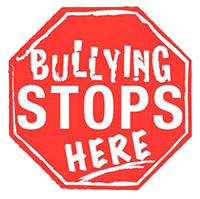What is Bullying?
GAPS is guided by the following definition from StopBullying.Gov, a federal government website managed by the U.S. Department of Health and Human Services:

Bullying is unwanted, aggressive behavior among school aged children that involves a real or perceived power imbalance. The behavior is repeated, or has the potential to be repeated, over time.
In order to be considered bullying, the behavior must be aggressive and include:
- An Imbalance of Power: Kids who bully use their power—such as physical strength, access to embarrassing information, or popularity—to control or
harm others. Power imbalances can change over time and in different situations, even if they involve the same people. - Repetition: Bullying behaviors happen more than once or have the potential to happen more than once.
Bullying includes actions such as making threats, spreading rumors, attacking someone physically or verbally, and excluding someone from a group on purpose.
Types of Bullying
There are three types of bullying:
- Verbal bullying is saying or writing mean things. Verbal bullying includes:
- Teasing
- Name-calling
- Inappropriate sexual comments
- Taunting
- Threatening to cause harm
- Social bullying, sometimes referred to as relational bullying, involves hurting someone’s reputation or relationships. Social bullying includes:
- Leaving someone out on purpose
- Telling other children not to be friends with someone
- Spreading rumors about someone
- Embarrassing someone in public
- Physical bullying involves hurting a person’s body or possessions. Physical bullying includes:
- Hitting/kicking/pinching
- Spitting
- Tripping/pushing
- Taking or breaking someone’s things
- Making mean or rude hand gestures
GAPS Board Policy regarding Bullying

What is Cyberbullying?
Cyberbullying is the use of modern communication technologies, such as but not limited to e-mail, instant messaging, chat rooms, websites, social media/networks, text messaging used to intentionally embarrass, humiliate, threaten or intimidate an individual or group in an attempt to gain power and control.


- How to talk with educators at your child’s school about bullying Get advice on how to communicate with teachers and other leaders at your child’s school if you’re dealing with bullying.
- Tips for parents: What to do if your child is being bullied Get tips for supporting your child through this very painful experience.
- Spanish version: Consejos para los padres
- Tips for parents: What to do if your child bullies others. If your child bullies others at school, it needs to stop. Find out what you can do at home.
- Spanish version: Consejos para los padres
- Tips for parents: What to do if your child witnesses bullying. Empower your child to take positive action in bullying situations and help prevent further bullying.
- Spanish version: Consejos para los padres
- What can parents do to prevent and address cyber-bullying? Protect your child from indirect forms of bullying that use text messaging, Websites, and cell phones.
- An Educator’s Guide to Combat Bullying and Bullying Prevention Resources for classroom teachers.
- Kids Against Bullying Website designed for elementary school students to learn about bullying prevention.
